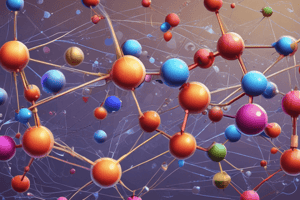Podcast
Questions and Answers
What is the primary focus of the discussion regarding dhruviyata?
What is the primary focus of the discussion regarding dhruviyata?
- The scientific implications of fixed stars.
- The cultural significance of astrology in ancient societies.
- The historical evolution of celestial navigation.
- The philosophical interpretations of permanence. (correct)
Which aspect is least likely to be associated with the conclusion of dhruviyata?
Which aspect is least likely to be associated with the conclusion of dhruviyata?
- Shifts in social hierarchy.
- The nature of time and space.
- The physical properties of stars. (correct)
- Variability of human beliefs.
Which misconception might arise from the interpretation of dhruviyata?
Which misconception might arise from the interpretation of dhruviyata?
- That it solely focuses on astronomical phenomena. (correct)
- That it extends concepts of stability to human behavior.
- That it has no relevance in modern philosophy.
- That it is directly related to economic theories.
Which outcome is expected from the exploration of dhruviyata?
Which outcome is expected from the exploration of dhruviyata?
In what way does dhruviyata challenge conventional thought?
In what way does dhruviyata challenge conventional thought?
Flashcards
Dhruviyata
Dhruviyata
Dhruviyata refers to the concept of polarity or having two opposing ends or forces. It's a fundamental principle in various fields.
Ant
Ant
Ant means 'end' or 'limit' in Sanskrit.
Dhruviyata Ka Ant
Dhruviyata Ka Ant
This phrase translates to 'End of Polarity' in English. It suggests a state where the duality of opposing forces ceases to exist.
The Significance of 'Dhruviyata Ka Ant'
The Significance of 'Dhruviyata Ka Ant'
Signup and view all the flashcards
Examples of Dhruviyata in Everyday Life
Examples of Dhruviyata in Everyday Life
Signup and view all the flashcards
Study Notes
Dhruviyata Ka Ant
- Dhruviyata (polarity) refers to the tendency of a substance or phenomenon to exist in two opposing states or forms.
- This concept manifests in various fields, including physics, chemistry, and even social sciences. It often arises from fundamental asymmetries in underlying structures or interactions.
- In physics, magnetic fields demonstrate polarity with north and south poles. Electric charges demonstrate polarity as positive and negative.
- In chemistry, molecules exhibit polarity based on the unequal sharing of electrons in their bonds. This polarity influences the interactions between molecules.
- Polarity can also be observed in social structures and systems. For example, societal structures might exhibit political polarization, economic inequality, or ideological divergence. There are positive and negative aspects in all these.
- The concept of the "end" of polarity is complex, frequently not a singular event, and depends heavily on the context in which it is examined. There isn't a definitive 'end' to polarity in any physical sense, but changes in configurations or manifestation of polarity happen.
- Sometimes a system may transition from a polarized state to a more balanced, or even less polarized, state.
- The opposing forces or elements of a polarized system might eventually neutralise or reconcile, leading to a reduction but not elimination of the polarity.
- Processes like equilibrium or synthesis can sometimes diminish or alter the visible manifestation of polarity. But the fundamental underlying mechanisms that permit polarity likely remain.
- The "end" of polarity could also refer to a point where the effects of polarization are no longer significant. A lack of practical significance is not necessarily a physical "end" of polarity.
- The 'end' could refer to a threshold beyond which the effects of polarity are superseded by stronger influences. However, such a definition is context dependent.
- In some cases, the 'end' of polarity could involve a complete reversal or transformation of the polarized state.
- The analysis of 'ending' polarity requires a clear definition of what constitutes a complete end, and precisely what form of polarization is undergoing change. This needs to be meticulously defined.
- A thorough understanding of polarity's cause, mechanisms, and characteristics is necessary to consider how it might cease to exist.
- No single, universally applicable answer exists for what constitutes the "end" of polarity. It varies widely depending on the specific system or phenomenon being considered.
Specific Examples in Different Fields
-
In magnetism, the 'end' of polarity might refer to a material becoming non-magnetic, through loss of alignment in the magnetic domains. This is a change in state, not an "end" in a philosophical sense.
-
In biology, the 'end' of polarity might be related to a cell losing its directional properties, for example during differentiation.
-
In social systems, the 'end' of polarity could potentially mean a period of significant compromise, negotiation, or consensus-building.
-
Polarity can be a useful concept, enabling classification and understanding of phenomena. The idea of an 'end' remains highly situational and context-specific.
Studying That Suits You
Use AI to generate personalized quizzes and flashcards to suit your learning preferences.
Description
Explore the concept of polarity, or dhruviyata, which highlights the duality found in various fields such as physics, chemistry, and social sciences. This quiz delves into how opposing states manifest in magnetic fields, molecular interactions, and societal structures, providing a comprehensive understanding of this multifaceted topic.




